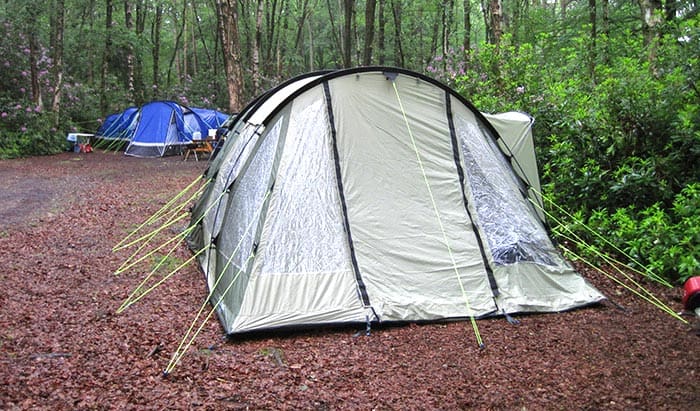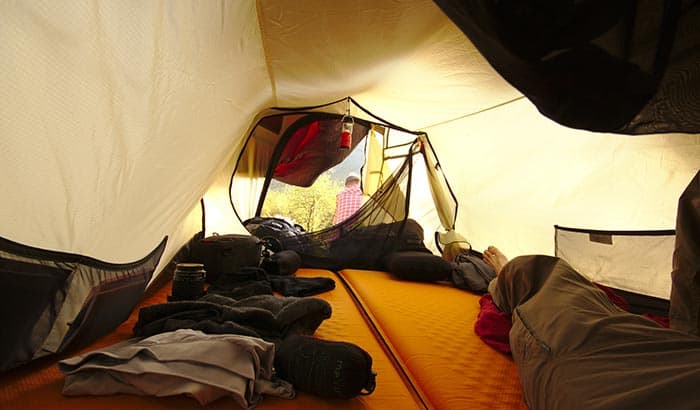If you plan to have an overnight camping trip, you better make sure you know all about how to keep your tent dry inside. You do not want to wake up on a wet floor, wet bags, and everything else. You can avoid a damp tent if you prepare to take the proper precautions.
How Does Your Tent Get Wet Inside
Before we discuss how to keep your tent dry inside, let us first know the common causes of your tent getting wet.
Rain and Morning Dew
The most common reasons are rain and morning dew. If your tent has poor waterproofing or any tear or opening where water can seep in, then you can expect water inside your tent by the morning.
Condensation
Condensation due to high humidity is another cause of the wetness inside your tent. The cold temperature of your tent converts the hot air into water vapor that accumulates on the inner surface of your tent, therefore the wetness.
How to Keep the Inside of Your Tent Dry
Although the reasons are natural, it is not an excuse to bear the discomfort a wet tent can bring. Aside from that, it can also save you from getting sick and your equipment from damage. Arguably, knowing how to keep the inside of your tent dry is as important as knowing how to set it up. And you can ensure the dryness inside using these tips for the best camping experience.
Tip 1: Waterproofing Your Tent
Every adventure seeker must test out their equipment before setting out; the same goes for your tent. Check your tent for any tears or cracks where water can get through. You want these patched up or, better yet, replace the tent altogether.
Test the waterproof effectivity days before your camp out. Spray down water on it for a few minutes and observe if the water seeps through the tent. If it does, then you better get some waterproofing done.
To waterproof your whole tent, you can buy a tent sealant you can easily apply yourself. There are many options in the market you can choose from. Take into account the type of fabric your tent is made of, and check first in the sealant packaging if the sealant is made for that fabric.
Tip 2: Proper Ventilation
In the case that it is humid or it rains, make sure your tent is well ventilated. You want the hot air to be released outside instead of vaporizing inside the tent. As discussed above, the condensation of the warm air causes water to pool on the tent surface.
Of course, I don’t mean to open your tent during a downpour but allow a tiny opening where rain cannot come through if possible. However, if there is no such opening, it is better to wait for the rain to stop before opening any ventilation.
You might also want to check the weather as you plan your camping trip. If you can avoid the humid and rainy days, that will lessen your worry about a wet campout.
Tip 3: Choose the Right Location to Set Up Camp
Before setting up camp, examine the area in which you will set up. It is ideal to set up on the higher ground to avoid water from pooling around your camp in case it rains. Areas near a body of water also tend to have higher humidity, so you might want to stay clear of those.
The perfect place would be where you are protected from rain and strong wind. Look also for a place with a small number of annoying bugs. Under a huge tree would be excellent, considering that there are few insects and good ventilation.
Tip 4: Avoid Getting Wet Items Into the Tent
It is essential to have separate wet and dry zones to keep the inside of your tent dry. Keep the damp clothing, equipment, and other things from getting inside the tent.
If you can afford to set up another tent to keep your wet stuff, then you might want to add that to your camp-out checklist. Having a place where you can store your wet shoes, jackets, camping gear, and other wet belongings reduces the water that can evaporate inside your tent.
Reduce wet items and any vapor from inside the tent. Cook and boil water outside as much as you can. If you must keep your wet clothing inside, put them in a sealable bag to prevent the humidity inside the tent from rising.
Last Words
Hard work always pays off; exert a little bit more effort for your next camping trip, and you will never regret it. Knowing how to keep your tent dry inside and doing them is never a burden if they are necessary to a comfortable and worry-free camping night out.


